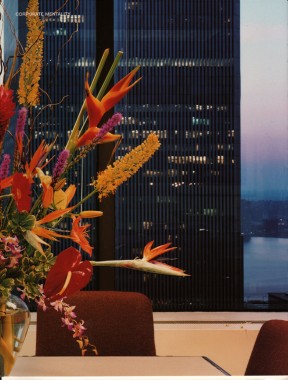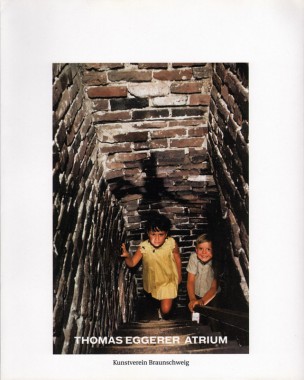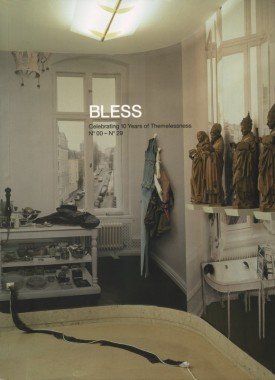
Aleksandra Mir, Corporate Mentality
Softcover, 256 pp., offset 4/1, 230 x 300 mm
Edition of 2000
ISBN 0-9711193-1-7
Published by Sternberg Press
$40.00 ·
Calling for a reassessment of the function of art in late capitalist society,
Corporate Mentality focuses on the complex and ambiguous ways artistic production inhabits corporate processes, abandoning the autonomy of the artwork in order to elaborate resistant approaches to a world increasingly determined by commercial strategies and market concerns.
Based on an archive (1995–2001) maintained by Aleksandra Mir, it presents a diverse spectrum of artists who take on business as site, as material, and as subject of their work. As Will Bradley writes in frieze, “The book focuses on … an essential area of interest as artists wake up to the reality of the Clinton-era fantasy of ethical corporatism. The plan came out of Mir and Kelsey’s realization that the publicity industry wasn’t stealing artists’ ideas, but simply employing artists, like Mir herself, who needed a day job. ‘Radical’ aesthetics that had taken at least six months to travel (we’re in New York here) from downtown to uptown were now transferred almost instantaneously, causing artists to reassess their methods.”
Absolute Vodka, Anthony Davies, Art, Atelier van Lieshout, Bennett Simpson, Bernadette Corporation, Carey Young, Claude Closky, Daniel Pflumm, Dejanov & Heger, Gareth James, John Kelsey, Lars Bang Larsen, Laura K. Jones, Liam Gillick, Matthieu Laurette, Piotr Uklanski, Purple Institute, RAM, Simon Ford, Sternberg Press, Superflex, Will Bradley

Thomas Eggerer, Atrium
Softcover, 72 pp., offset 4/1, 215 x 270 mm
Edition of 2000
ISBN 978-0-9726806-9-1
Published by Sternberg Press
$30.00 ·
“How can one make a work on canvas today without, in some way, addressing the mobility that now characterizes our most familiar sources of representational surfaces – the television or computer screen with their profusion of data, succeeding, interrupting and, through the hyperlink, opening gaps within one another? Thomas Eggerer’s anti-gravitational paintings address these conditions in a variety of ways, all of which cause a vertiginous loss of grounding.” David Joselit
German artist Thomas Eggerer (*1963) is based in Los Angeles since 1999. A former member of the collaborative Group Material in New York, he initiated conceptual projects in collaboration with Jochen Klein, focusing on identity and gender issues in public space. In his current paintings and drawings, Eggerer continues this discourse with other means. His enigmatic depictions of groups and collectives attempt less to portray the singularity of the individual than to explore the mechanisms of exclusion and inclusion, conformity and hierarchy, as well as the potential of individual or collective utopia.
Art, David Joselit, Diedrich Diederichsen, Karola Grässlin, Kunstverein Braunschweig, RAM, Sternberg Press, Thomas Eggerer

Bernadette Corporation, Eine Pinot Grigio, Bitte
Softcover, 150 pp., offset 4/1, 165 x 240 mm
Edition of 2000
ISBN: 978-1-933128-17-7
Published by Sternberg Press
$25.00 · out of stock
Formed in 1994, the Bernadette Corporation is a creative collective based in New York and Europe and organized around revolving memberships and associations. Its artistic output has ranged from fashion to film and literature, training videos, photography, etc., consistently insisting on the idea that the re-imagined format should inform the subject and give shape to its output. Whereas the first book released by BC was reportedly written by 150 people, in an “exquisite corpse” format, the second “novel,” entitled Be Corpse, is described as “a screenplay that cannot be a film” or “a film that can only be on paper.” A drama in three acts, the text seeks to make the gap between our primordial and contemporary selves collapse on itself, revealing an instinctless body and the brain manifest as the over-stimulated observer. Above all, Be Corpse should be received as the continuation of BC’s indirect, fiercely independent critique of our late capitalist/globalized world.
Art, Bernadette Corporation, Book Works, Fashion, Film, RAM, Sternberg Press

Bless, Celebrating 10 Years of Themelessness, Nº00 — Nº29
Softcover, 496 pp., offset 4/1 + fore-edge printing, 185 x 250 mm
Edition of 2000
ISBN 978-1-933128-15-3
Published by Sternberg Press
out of print
Bless came to fame in the winter of 97/98, when the models of a Martin Margiela fashion show wore Bless wigs made out of fur. Heralded as one of fashion’s most innovative designers, the Paris and Berlin-based duo (Desiree Heiss and Ines Kaag) quickly refused to capitalize on one milieu. Constantly investigating the boundaries of style, Bless slides from fashion to beauty, interior decoration to art exhibition, collaboration with other brands to stylized advertising. Their production, which sits on the fine line between art object and design, high function and high fashion, is always unique and marked by the recycling and adaptation of unexpected items put to use in a totally new way.
Designed by Manuel Raeder, this fully illustrated book features for the first time the wide range of Bless’ activity and documents a unique mode of cultural production.
Bless have exhibited internationally at the 1st berlin biennale (1998/99), Musée d’Art Moderne de la Ville de Paris (1999), Centre Pompidou (2000), Manifesta 4 (2002), Palais de Tokyo (2003), Moderna Museet, Stockholm (2004), and most recently at the Museum Boijmans Van Beuningen, Rotterdam (2006). Their collaborations with other brands range from Adidas to Levi’s, Nike, Mikli and Droog over to the jewellery designer Bucherer.
Adriano Sack, Art, Barbara Steiner, Bless, Culture, Desiree Heiss, Elein Fleiss, Fashion, Graphics, Ines Kaag, Manuel Raeder, Nakako Hayashi, Olivier Zahm, RAM, Stéphanie Moisdon, Sternberg Press, Thimo te Duits, Typography, Ulf Poschardt



